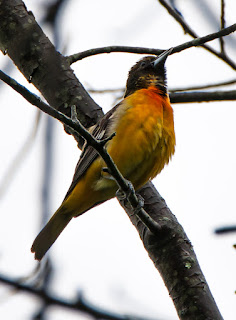On Saturday, May 13th, despite the heavy cloud cover and occasional drizzle we found that warbler migration season is in full swing! Luria Park was packed full of these colorful wee migrants who most will only be in our area for a few weeks before working their way northward.
We saw brilliant Chestnut-sided Warblers.
Wonderful Black-throated Blue Warblers which gleaned insects from under poison ivy leaves.
A male Magnolia Warbler playing hide and seek from the leafy branches.
A stripey Black and White Warbler.
A Blackpoll Warbler gobbling insects from beneath the leaves.
And a singing Black-throated Green Warbler.
A big early morning surprise was this young male Baltimore Oriole singing from the top of a tree in the Byrd's side yard!
AND if the day couldn't hold enough birdy awesomeness we saw two Mississippi Kites, rare birds to our area, perched high in dead branches near the first creek crossing on the boardwalk coming in from the Raymondale side of the park.
This bird has been seen in the Annandale area a few times in the past several years and has apparently nested in the the area as well. However, until recently this bird was primarily no further north than the Virginia Beach area. We will be keeping a close eye out for this wonderful raptor to see if he wants to nest in our park!
Dan and I are hosting a Raymondale Neighborhood bird walk in Luria Park on Tuesday, May 16th beginning at 5 p.m. We will meet at the info. kiosk on the Fallowfield side of the park. Please bring your binoculars and cameras (preferably with a good zoom lens). The warblers we may see are mostly a few inches long and you will need binoculars to see the details. The weather should be nice and sunny and the birds should be out! Who knows what we will see!









































